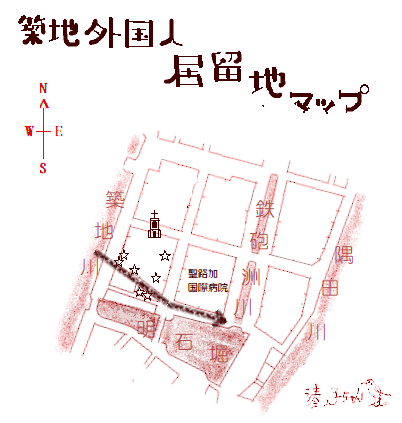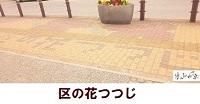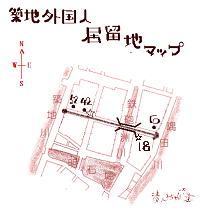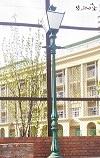 Hello, this is Minato kid.
Hello, this is Minato kid.
Today, I would like to walk "St. Luke Street" from Tsukiji 3-chome 8 to Akashicho 9.
The sunbeams on St. Luke Street is the dogwood, which was given by the United States as a sign of friendship.
From 1868 (1868) to 1899 (1899), Tsukiji foreign settlements were set up in the current Akashicho area, where many missionaries and doctors lived, and became a base for missionary activities in Japan. . It is an area closely related to the United States, such as the establishment of the United States Mission in 1875 (1875).
 ♪ Symbol of Akashicho St. Luke's
♪ Symbol of Akashicho St. Luke's
In 1900 (1900), a missionary doctor R. B Toysler came to Japan, and in 1934, Tsukiji Hospital was renamed St. Luke Hospital and launched. In 1937, St. Luke's Nursing School was opened, and the three basic structures of Toysler's aim of religion, medical care, and nursing education were established, and St. Luke's Hospital has developed significantly since then. In 1917 (1917), he changed his name to St. Luke's International Hospital.
The construction of St. Luke's International Hospital was originally designed by A. Raymond. Later, it was entrusted to J. Bergaminy, and in 1936 (1936), the Neo Gothic St. Luke Chapel was built. Even now, from the chapel, the sound of the bell echoes on time every day, reminiscent of the former foreign settlement era in Akashicho and surrounding areas.
♪ Monument on St. Luke Street
Monument of origin of Dutch studies
Ryotaku Maeno, a physician and orchid scholar of the Okudaira family of the Nakatsu clan in Buzen (now Oita Prefecture), translated the Dutch medical book "Tarher Anatomia" along with Genpaku Sugita, Junnan Nakagawa, Hoshu Katsuragawa and others. In 1774 (1774), "Dismantling New Book".
Monument of the birthplace of Keio Gijuku
Yukichi Fukuzawa (1835-1901), a native of the Nakatsu clan, opened a Dutch school in this area in 1858 (1858) and developed into the current Keio University.
Monument of the Birthplace of Women's Academy
In 1870 (1870), missionary Julia Karo Sols founded A6 Women's School, the predecessor of the Women's Academy. Tsukiji This Western-style building was built for the first time in a foreign settlement, attracting the attention of people. (Different from the actual old location)
Monument to the birthplace of Rikkyo Gakuin
In 1874 (1874), Primate C. M Williams opened a private school, Rikkyo School, the roots of Rikkyo Gakuin.
Toysler Memorial Hall
It was built in 1933 as a missionary building at St. Luke's International Hospital. On the exterior, you can see a Western-style architectural design that expresses the framework of pillars and beams. At present, it has been relocated and restored to the courtyard in the hospital.
Monument to the site of Takumi Asanouchi's residence
This is the site of the residence of Chushingura's famous Akaho feudal lord Asanouchi Takumi Naganori. In 1701 (1701), a sword wound incident that occurred in Edo Castle was ordered to be silent and his house was cut off.
Information board for the birth of Ryunosuke Akutagawa
Ryunosuke Akutagawa (1892-1927) was born here in 1892 as the eldest son of a milk ranch called Komakisha. He entered the gate of Soseki Natsume and left many works, such as "Kappa", "Rashomon", and "The Life of Anime".
♪ Welcome to the sidewalk museum!

It's a fashionable place to tell the former Tsukiji foreign settlement, such as a picture of a gas lamps and the address of the settlement. (Photo taken in April 2018)

On the sidewalk of the former Akatsuki Bridge, there are letters "flower azaleas in the ward" shaped by pavement blocks and pictures of azaleas. The colorful objects on the bridge are inspired by the wind. From this year, a new flower bed at the “Flowering Town Corner” has been set up, and it is a lively street, coupled with the lively traffic of people.
The colorful objects on the bridge are inspired by the wind. From this year, a new flower bed at the “Flowering Town Corner” has been set up, and it is a lively street, coupled with the lively traffic of people.
Correspondent Minato kid, Chuo-ku Tourism Association

No. 27 November 23, 2018
 ♪ Characteristics of Tsukiji Foreign Settlements
♪ Characteristics of Tsukiji Foreign Settlements ♪ The brick walls and gas lamps that still remain
♪ The brick walls and gas lamps that still remain brick wall is characterized by a stacking method called "English style".
brick wall is characterized by a stacking method called "English style". There are also gas lamps that are thought to be from the end of the Meiji era.
There are also gas lamps that are thought to be from the end of the Meiji era.
 ♪ Henry Falls and Medical Activities
♪ Henry Falls and Medical Activities

